Aik Beng Ng
SegReConcat: A Data Augmentation Method for Voice Anonymization Attack
Aug 26, 2025Abstract:Anonymization of voice seeks to conceal the identity of the speaker while maintaining the utility of speech data. However, residual speaker cues often persist, which pose privacy risks. We propose SegReConcat, a data augmentation method for attacker-side enhancement of automatic speaker verification systems. SegReConcat segments anonymized speech at the word level, rearranges segments using random or similarity-based strategies to disrupt long-term contextual cues, and concatenates them with the original utterance, allowing an attacker to learn source speaker traits from multiple perspectives. The proposed method has been evaluated in the VoicePrivacy Attacker Challenge 2024 framework across seven anonymization systems, SegReConcat improves de-anonymization on five out of seven systems.
Feature-based Graph Attention Networks Improve Online Continual Learning
Feb 13, 2025Abstract:Online continual learning for image classification is crucial for models to adapt to new data while retaining knowledge of previously learned tasks. This capability is essential to address real-world challenges involving dynamic environments and evolving data distributions. Traditional approaches predominantly employ Convolutional Neural Networks, which are limited to processing images as grids and primarily capture local patterns rather than relational information. Although the emergence of transformer architectures has improved the ability to capture relationships, these models often require significantly larger resources. In this paper, we present a novel online continual learning framework based on Graph Attention Networks (GATs), which effectively capture contextual relationships and dynamically update the task-specific representation via learned attention weights. Our approach utilizes a pre-trained feature extractor to convert images into graphs using hierarchical feature maps, representing information at varying levels of granularity. These graphs are then processed by a GAT and incorporate an enhanced global pooling strategy to improve classification performance for continual learning. In addition, we propose the rehearsal memory duplication technique that improves the representation of the previous tasks while maintaining the memory budget. Comprehensive evaluations on benchmark datasets, including SVHN, CIFAR10, CIFAR100, and MiniImageNet, demonstrate the superiority of our method compared to the state-of-the-art methods.
On-Device LLMs for SMEs: Challenges and Opportunities
Oct 21, 2024Abstract:This paper presents a systematic review of the infrastructure requirements for deploying Large Language Models (LLMs) on-device within the context of small and medium-sized enterprises (SMEs), focusing on both hardware and software perspectives. From the hardware viewpoint, we discuss the utilization of processing units like GPUs and TPUs, efficient memory and storage solutions, and strategies for effective deployment, addressing the challenges of limited computational resources typical in SME settings. From the software perspective, we explore framework compatibility, operating system optimization, and the use of specialized libraries tailored for resource-constrained environments. The review is structured to first identify the unique challenges faced by SMEs in deploying LLMs on-device, followed by an exploration of the opportunities that both hardware innovations and software adaptations offer to overcome these obstacles. Such a structured review provides practical insights, contributing significantly to the community by enhancing the technological resilience of SMEs in integrating LLMs.
A General-Purpose Multimodal Foundation Model for Dermatology
Oct 19, 2024



Abstract:Diagnosing and treating skin diseases require advanced visual skills across multiple domains and the ability to synthesize information from various imaging modalities. Current deep learning models, while effective at specific tasks such as diagnosing skin cancer from dermoscopic images, fall short in addressing the complex, multimodal demands of clinical practice. Here, we introduce PanDerm, a multimodal dermatology foundation model pretrained through self-supervised learning on a dataset of over 2 million real-world images of skin diseases, sourced from 11 clinical institutions across 4 imaging modalities. We evaluated PanDerm on 28 diverse datasets covering a range of clinical tasks, including skin cancer screening, phenotype assessment and risk stratification, diagnosis of neoplastic and inflammatory skin diseases, skin lesion segmentation, change monitoring, and metastasis prediction and prognosis. PanDerm achieved state-of-the-art performance across all evaluated tasks, often outperforming existing models even when using only 5-10% of labeled data. PanDerm's clinical utility was demonstrated through reader studies in real-world clinical settings across multiple imaging modalities. It outperformed clinicians by 10.2% in early-stage melanoma detection accuracy and enhanced clinicians' multiclass skin cancer diagnostic accuracy by 11% in a collaborative human-AI setting. Additionally, PanDerm demonstrated robust performance across diverse demographic factors, including different body locations, age groups, genders, and skin tones. The strong results in benchmark evaluations and real-world clinical scenarios suggest that PanDerm could enhance the management of skin diseases and serve as a model for developing multimodal foundation models in other medical specialties, potentially accelerating the integration of AI support in healthcare.
Nutrition Estimation for Dietary Management: A Transformer Approach with Depth Sensing
Jun 04, 2024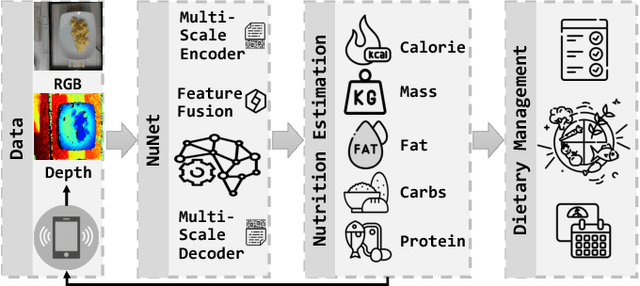
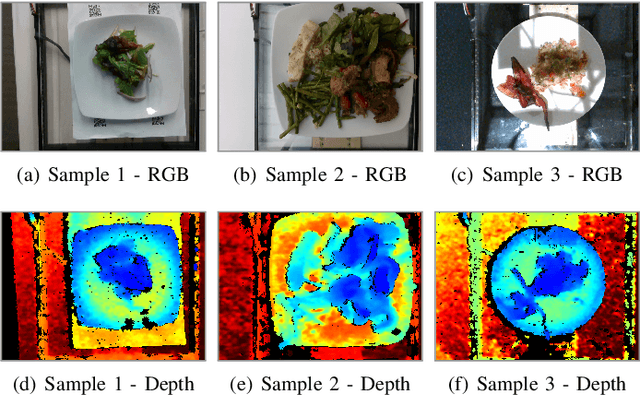
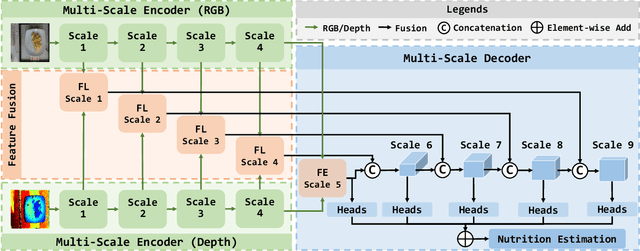

Abstract:Nutrition estimation is crucial for effective dietary management and overall health and well-being. Existing methods often struggle with sub-optimal accuracy and can be time-consuming. In this paper, we propose NuNet, a transformer-based network designed for nutrition estimation that utilizes both RGB and depth information from food images. We have designed and implemented a multi-scale encoder and decoder, along with two types of feature fusion modules, specialized for estimating five nutritional factors. These modules effectively balance the efficiency and effectiveness of feature extraction with flexible usage of our customized attention mechanisms and fusion strategies. Our experimental study shows that NuNet outperforms its variants and existing solutions significantly for nutrition estimation. It achieves an error rate of 15.65%, the lowest known to us, largely due to our multi-scale architecture and fusion modules. This research holds practical values for dietary management with huge potential for transnational research and deployment and could inspire other applications involving multiple data types with varying degrees of importance.
Dependently Typed Knowledge Graphs
Mar 08, 2020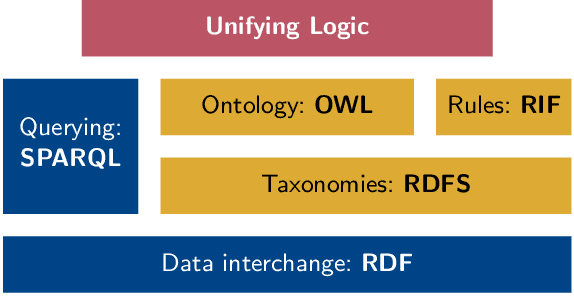
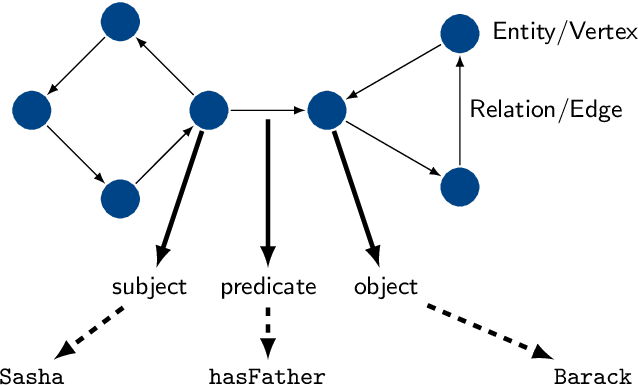
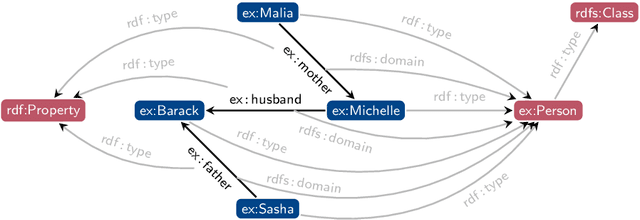

Abstract:Reasoning over knowledge graphs is traditionally built upon a hierarchy of languages in the Semantic Web Stack. Starting from the Resource Description Framework (RDF) for knowledge graphs, more advanced constructs have been introduced through various syntax extensions to add reasoning capabilities to knowledge graphs. In this paper, we show how standardized semantic web technologies (RDF and its query language SPARQL) can be reproduced in a unified manner with dependent type theory. In addition to providing the basic functionalities of knowledge graphs, dependent types add expressiveness in encoding both entities and queries, explainability in answers to queries through witnesses, and compositionality and automation in the construction of witnesses. Using the Coq proof assistant, we demonstrate how to build and query dependently typed knowledge graphs as a proof of concept for future works in this direction.
 Add to Chrome
Add to Chrome Add to Firefox
Add to Firefox Add to Edge
Add to Edge